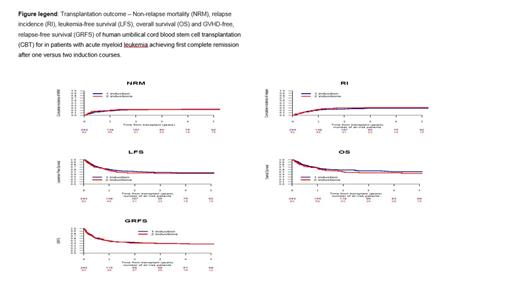Abstract
Background: Achieving a first complete remission (CR1) is an important prognostic factor for transplantation outcome. However, there are no data in the setting of cord blood transplantation (CBT) indicating whether the number of induction courses (1 or 2) needed to achieve CR1, is of prognostic significance. As CBT is advantageous for acute myelogenous leukemia (AML) patients (pts) with positive pre transplant measurable residual disease (MRD) (Milano F, NEJM 2016), it is conceivable that in the CBT setting, no difference in transplantation outcome will be observed between pts achieving CR1 after 1 or 2 inductions.
Methods: Using the European Society for Blood and Marrow Transplantation (EBMT)/Acute Leukemia Working Party (ALWP) registry, we compared transplantation outcomes of adult pts aged ≥18 years with AML that underwent CBT in 2005-2020 in CR1, achieved following 1 versus (vs) 2 induction courses. Multivariate analysis (MVA) adjusting for differences between the induction groups was performed using a Cox's proportional-hazards regression model for main outcomes.
Results: Three hundred and twenty-five pts were included comprising 243 (75%) with 1 and 82 (25%) with 2 induction chemotherapy courses. Median (range) follow-up was 65.4 (57.4-73.5) and 51.0 (34.8-61.5) months, respectively (p=0.6). Median age was 49.4 (19.0-70.9) and 52.1 (19.2-71.5) years (p=0.8), respectively. For patients with 1 and 2 induction courses, respectively, 49.4% and 57.3% were male, 225 (92.6%) and 78 (95.1%) pts had de novo AML, and 18 (7.4%) and 4 (4.9%) had secondary AML (p=0.6). Pts with 1 and 2 induction courses, respectively, were classified by cytogenetic risk as follows: intermediate, 62.0% and 79.2%, adverse, 33.2% and 19.5%, and favorable, 4.8% and 1.3% (p=0.02) (missing data~25%). The FLT3-ITD mutation was harbored by 33.7% and 32.3% of the pts (p=0.8), respectively (missing data ~6%). Conditioning was myeloablative (MAC) in 43.0% and 36.6% and reduced intensity (RIC) in 57.0% and 63.4%, respectively (p=0.31). Karnofsky performance score (KPS) was > 90 in 74.7% and 71% of the pts, respectively (p=0.5). The most frequent anti-graft-versus-host disease (GVHD) prophylaxis was cyclosporin A (CSA) and mycophenolate mofetil (MMF) in 75.6% and 82.5 %, or CSA with or without steroids in 16.1 % and 11.2%, respectively. Anti-thymocyte globulin (ATG) was administered to 32.9% and 25.6% of the CBT recipients, respectively (p=0.2). Engraftment rates were lower for pts achieving CR1 after 1 vs 2 induction courses (91.3% and 98.8% p=0.02) with corresponding day 60 absolute neutrophil count (ANC) > 0.5 x 10 9/L in 89.6% vs 96.3% of the pts (p=0.03).
Day 180 incidence of acute GVHD grades II-IV was similar in both induction groups, 38.3% and 37.2% (p=0.8), as was 2-year total chronic GVHD, 23.4% and 27.5 %, respectively (p=0.6). In univariate analysis, the 2--year non-relapse mortality (NRM), relapse incidence (RI), leukemia-free survival (LFS), overall survival (OS) and GVHD-free, relapse-free survival (GRFS) were similar between patients achieving CR1 with 1 vs 2 induction courses with 22.6% vs 23.6% (p=0.87) 25.1% vs 30.4% (p=0.4), 52.3% vs 46.0% (p=0.3), 58.6% vs 50.0% (p=0.2), and 44% vs 44.1% (p=0.66), respectively. Similarly in MVA, there was no significant association between 2 courses of induction and NRM (hazard ratio (HR) = 1.1; 95% CI, 0.6-1.8, p=0.7), RI (HR = 1.4; 95% CI, 0.9-2.3, p=0.1), LFS (HR = 1.3; 95% CI, 0.9-1.8, p=0.2), OS (HR = 1.3; 95% CI, 0.9-1.9, p=0.1), and GRFS (HR = 1.1; 95% CI, 0.8-1.5, p=0.5).
Conclusions: In CBT recipients, we did not find any significant differences in outcomes in patients achieving CR1 after one or two induction courses. Notably, engraftment was better in patients receiving two courses of induction chemotherapy.
Labopin: Jazz Pharmaceuticals: Honoraria. Forcade: Novartis: Other: travel grant. Sierra: Amgen: Other: Educational grant; Roche: Other: Educational grant; Astellas: Consultancy, Membership on an entity's Board of Directors or advisory committees, Research Funding, Speakers Bureau; Alexion: Other: Educational grant; Jazz Pharmaceuticals: Research Funding; Janssen: Other: Educational grant; Novartis: Honoraria, Research Funding, Speakers Bureau; Abbvie: Honoraria, Membership on an entity's Board of Directors or advisory committees, Speakers Bureau; Pfizer: Honoraria; BMS Celgene: Honoraria, Research Funding. Byrne: Incyte: Honoraria. Blaise: Jazz Pharmaceuticals: Honoraria. Mohty: Sanofi: Honoraria, Research Funding; Pfizer: Honoraria; Novartis: Honoraria; Takeda: Honoraria; Jazz: Honoraria, Research Funding; Janssen: Honoraria, Research Funding; Gilead: Honoraria; Celgene: Honoraria, Research Funding; Bristol Myers Squibb: Honoraria; Astellas: Honoraria; Amgen: Honoraria; Adaptive Biotechnologies: Honoraria.


